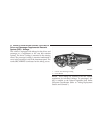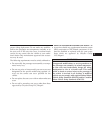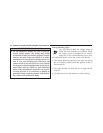
WARNING!
Ignoring the Airbag Warning Light in your instru-
ment panel could mean you won’t have the airbags to
protect you in a collision. If the light does not come
on, stays on after you start the vehicle, or if it comes
on as you drive, have the airbag system checked right
away.
Driver Airbag/Passenger Airbag Inflator Units
The Driver Airbag Inflator Unit is mounted in the steer-
ing wheel. The Passenger Airbag Inflator Unit is
mounted underneath a cover in the passenger side of the
instrument panel. When the ORC detects a collision
requiring the airbags, it signals the inflator units. A large
quantity of non-toxic gas is generated to inflate the
airbags. Different airbag inflation rates may be possible
based on collision severity and occupant size. The steer-
ing wheel hub trim cover and the upper right side of the
instrument panel separate and then fold out of the way,
as the bags inflate to their full size. The bags inflate fully
in about 50 to 70 ms. This is about half of the time it takes
to blink your eyes. The bags then deflate quickly while
helping to restrain the driver and passenger. The airbag
gas is vented toward the instrument panel through vent
holes in the airbag material. In this way, the airbags do
not interfere with your control of the vehicle.
Occupant Classification Module (OCM)
The Occupant Classification Module (OCM) is located
underneath the passenger seat. The OCM uses input
from the Flex Mat to classify the occupant in the passen-
ger seat into a size category. The OCM communicates this
information to the ORC. The ORC may modify the rate of
passenger airbag inflation or prevent passenger airbag
deployment based on occupant classification.
If there is a fault present in the OCS, the Airbag Warning
Light will turn on. This indicates that you should take the
50 THINGS TO KNOW BEFORE STARTING YOUR VEHICLE


















